Historical Content
The results of deep dives into the Survey of Current Business archives, providing noteworthy memorabilia by decade, including photos, excerpts, advertisements, data presentations, and other interesting items chronicling the Survey’s 100 years of reliable, timely, and unbiased publication.
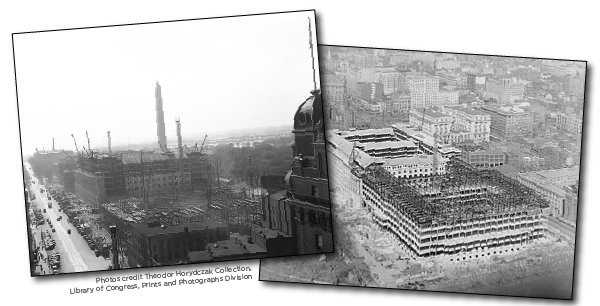
[Click to expand]
Construction of the Department of Commerce (DOC) Building, where the Survey was produced in its early days. Both the building and the journal got off the ground in the 1920s. Seven stories high, the largest office building at that time, and located in the Federal Triangle area of Washington, DC, it was renamed the Herbert C. Hoover Building in 1981 in honor of the former Secretary of Commerce and U.S. President.
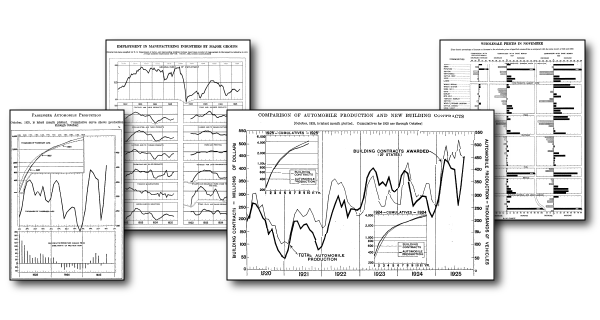
[Click to expand]
Selected content from the December 1925 issue of the Survey, which provided tables and charts of business indicators and trends by industry and foreign trade data.

[Click to expand]
Beginning with the March 1922 issue, the date appearing on the cover referred to the date of the issue and not the date of the statistics contained in the Survey. The earliest Surveys were mimeographed, 10-page documents.
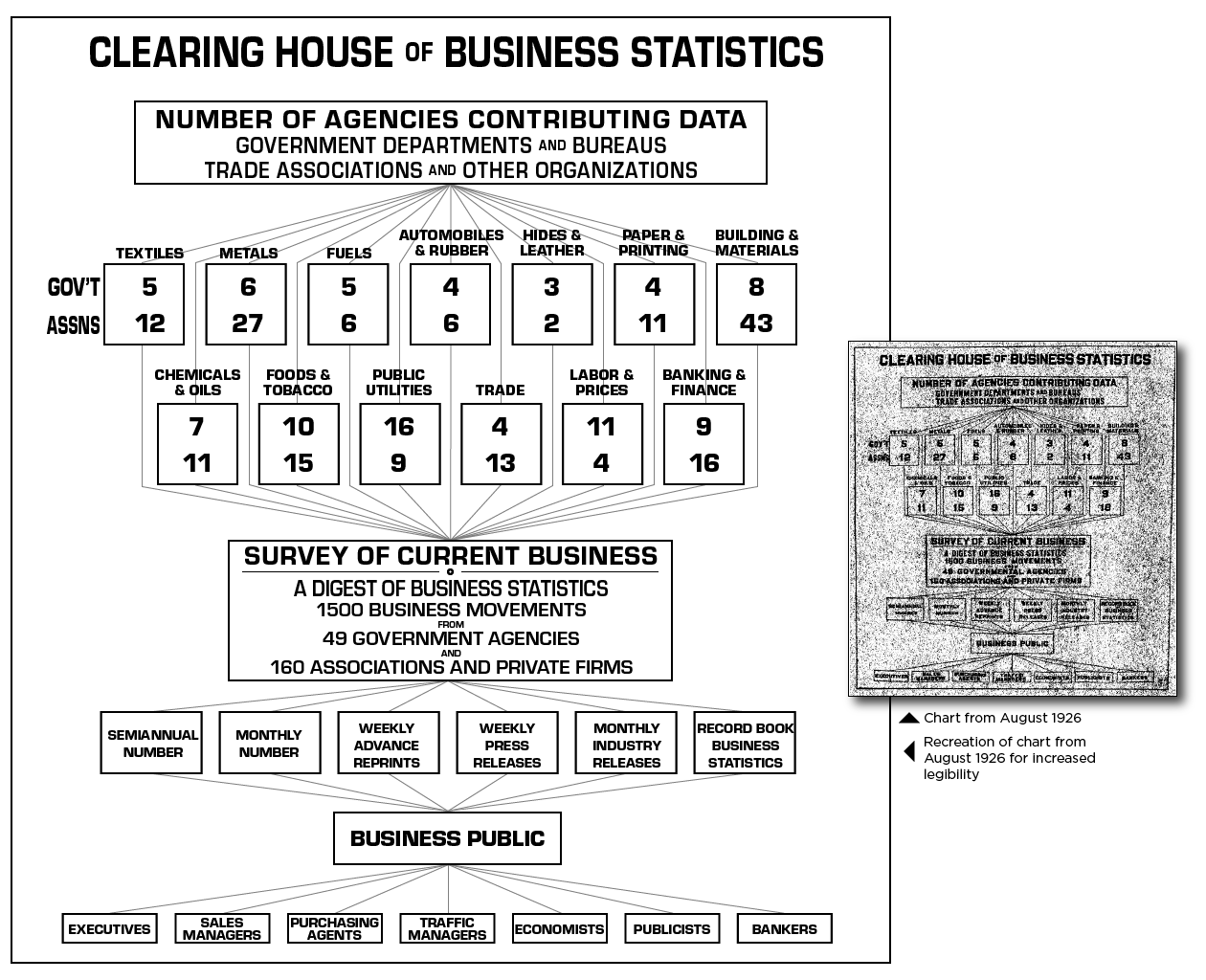
[Click to expand]
“The Clearing House of Business Statistics” was a collaboration of government departments and bureaus, trade associations, think tanks, and other organizations. This chart from the August 1926 issue explains its data-gathering structure.
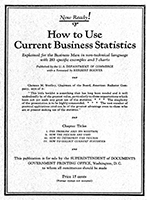
[Click to expand]
The DOC publication How to Use Current Business Statistics was subtitled “Explained for the Business Man in non-technical language with 283 specific examples and 7 charts.” It contained a foreword by Herbert Hoover and cost 15 cents.

[Click to expand]
In August 1929, a subscription to the Survey cost from $1.50 a year to $5.50 per year if it included Commerce Reports. A single monthly copy cost 10 cents. Payment could be made by postal money order, express order, or New York draft.

[Click to expand]
[The above advertisements appear in the October 1934, November 1937, May 1938, June 1938, and November 1939 issues.]
During the 1930s, the Survey of Current Business began running advertisements for Department of Commerce products. These ads were usually on the inside front or inside back covers of the publication. Featured here are some of the more visually interesting ads from the 1930s.

[Click to expand]
Advertisements appeared in the Survey for the Department of Commerce's 1936 and 1937 Foreign Trade Weeks reports. The 1937 report also commemorated the 25th anniversary of the creation of the Bureau of Foreign and Domestic Commerce.

[Click to expand]
A glimpse into the production of the Survey during its early years is shown here in the first Survey-published message from a Bureau director in March 1938. Note that a different division within the Bureau of Foreign and Domestic Commerce would take over publishing the Survey in September 1938.
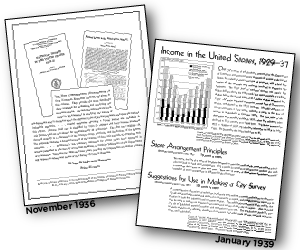
[Click to expand]
Advertisements appeared in the Survey for the 1929–1932 and 1929–1937 National Income in the United States reports, both updated editions of the groundbreaking National Income, 1929–32 report.

[Click to expand]
From October 1941 to July 1944, the Survey of Current Bussiness began each issue with a summary page titled Economic Highlights. These pages featured a quick-read, single-page analysis of recent data on subjects of particular interest to Survey readership.
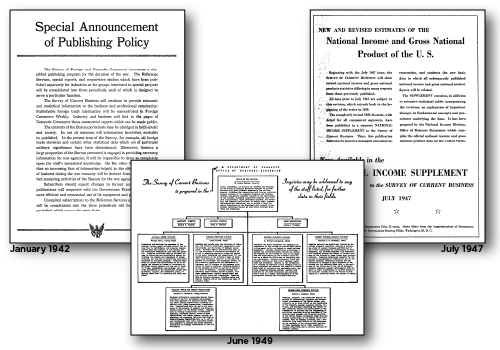
[Click to expand]
During the 1940s, the Bureau of Foreign and Domestic Commerce, publisher of the Survey, made some policy changes, including establishing a simplified publishing program for the duration of World War II, switching to revised national income and gross national products statistics, and announcing that the Survey is now prepared in the Office of Business Economics.
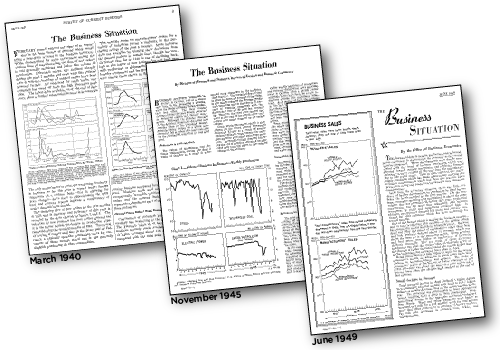
[Click to expand]
Beginning in March 1940, the Survey reorganized its contents to begin each issue with a new section titled The Business Situation. This introductory section featured a summary of economic developments over the past month and evolved over the decade to feature several subsections including charts and tables. This new feature eventually evolved to what is now GDP and the Economy.
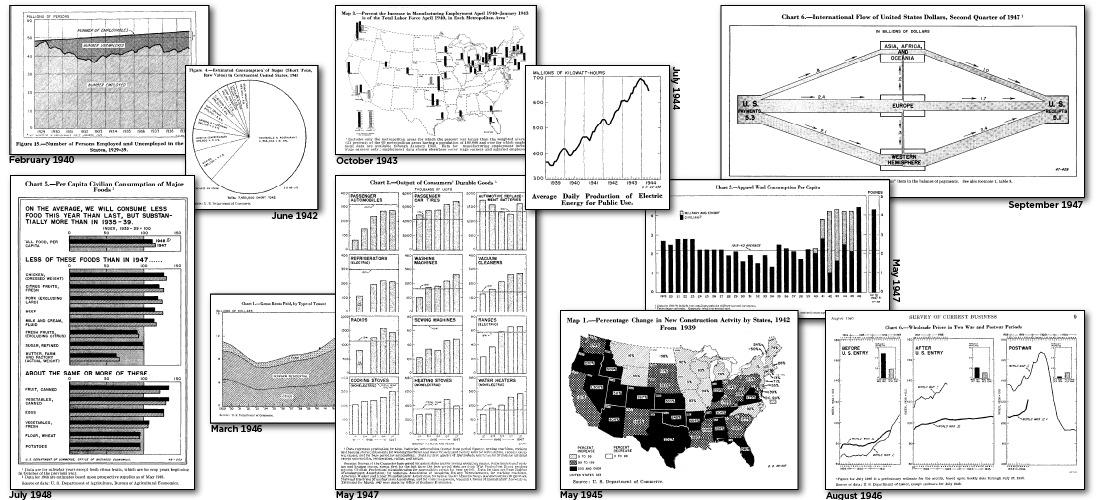
[Click to expand]
Throughout the 1940s, the Survey continued illustrating data about the country's economic situation and industries using innovative and creative charts.
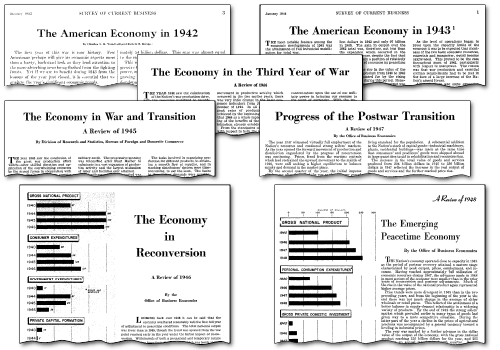
[Click to expand]
1943 • 1944 • 1945 • 1946 • 1947 • 1948 • 1949
Every year during the 1940s, the Survey published an annual issue. Each annual issue—which cost 5¢ more than regular issues—featured an overarching theme, some of which are shown here.
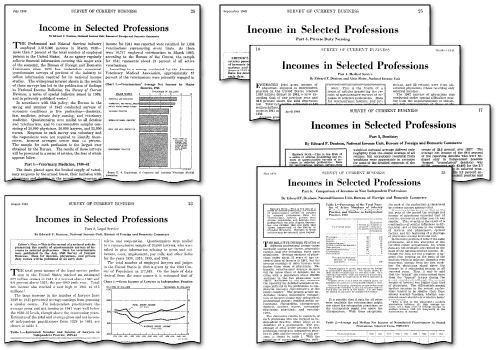
[Click to expand]
Beginning in 1943, the Survey published a six-part series of articles on professional incomes, focusing on veterinary medicine, the legal service, nursing, medical services, and dentistry, culminating in May 1944 with an article comparing nine independent professions.
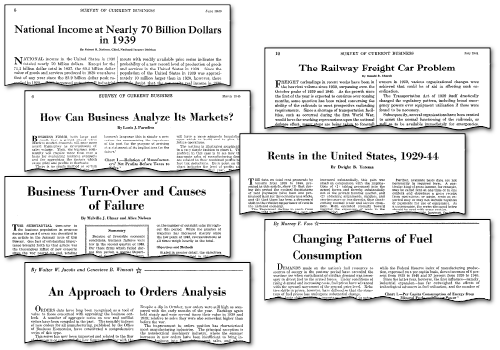
[Click to expand]
During the 1940s, the Survey published many interesting special articles, including features on national income, “the railway freight car problem,” business analysis of markets, rents in the United States, business turnover, fuel consumption, and orders analysis.
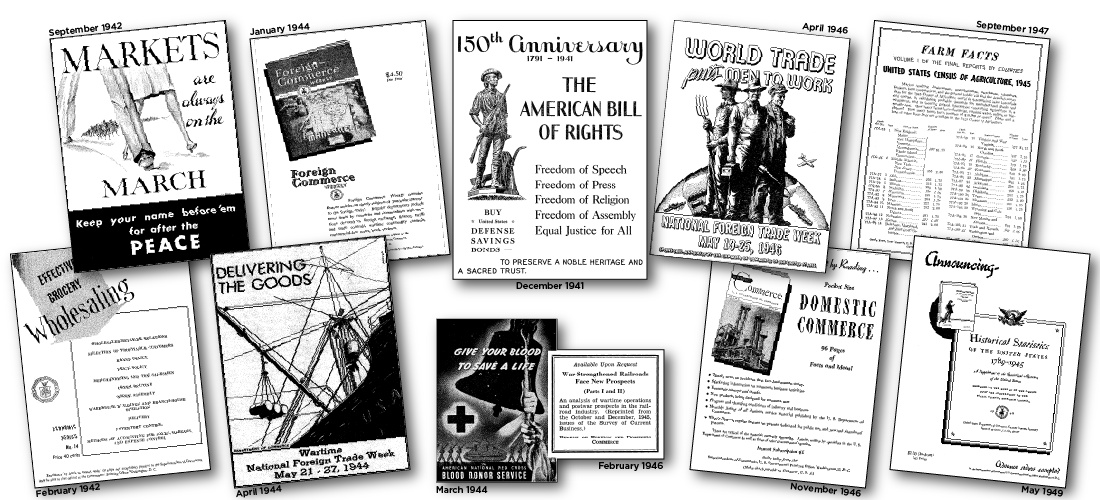
[Click to expand]
A selection of advertisements featured in 1940s issues of the Survey, including new smaller, column-width ads beginning in March 1944.

[Click to expand]
The Survey of Current Business had a number of “firsts” in the 1950s. These included the first annual index of special articles and features for Volume 30, the first international investment postion article in May 1954, and the first time an annual “Statistical Summary” appeared at the end of an annual issue.
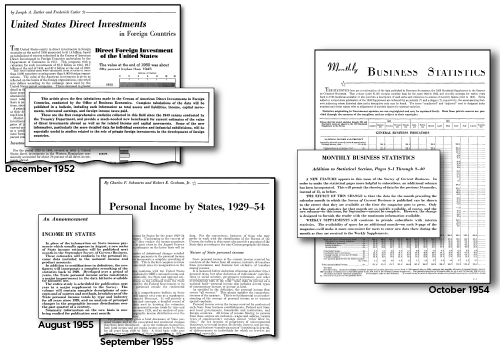
[Click to expand]
Updates and new data in the Survey during the 1950s, detailed in editorial notices, included the first tabulations of the Census of American Direct Investments in Foreign Countries (December 1952), a new addition to the Survey's long-standing “Monthly Business Statistics” section (October 1954), and the first appearance of the state personal income series (notice August 1955; data September 1955).
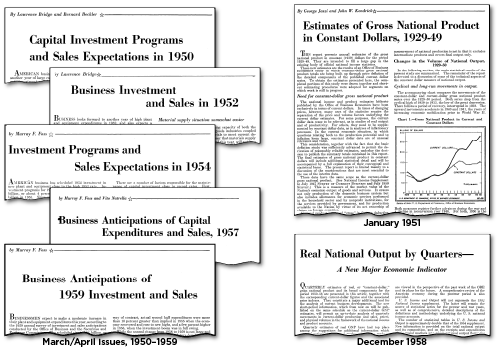
[Click to expand]
During the 1950s, the Survey continued the development of recurring articles. Every March or April, the Survey featured an article on business investment and sales expectations, and there were major improvements to gross national product (GNP) reporting, including the annual constant-dollar GNP article, which began in January 1951 and evolved into the quarterly constant-dollar GNP series in December 1958.
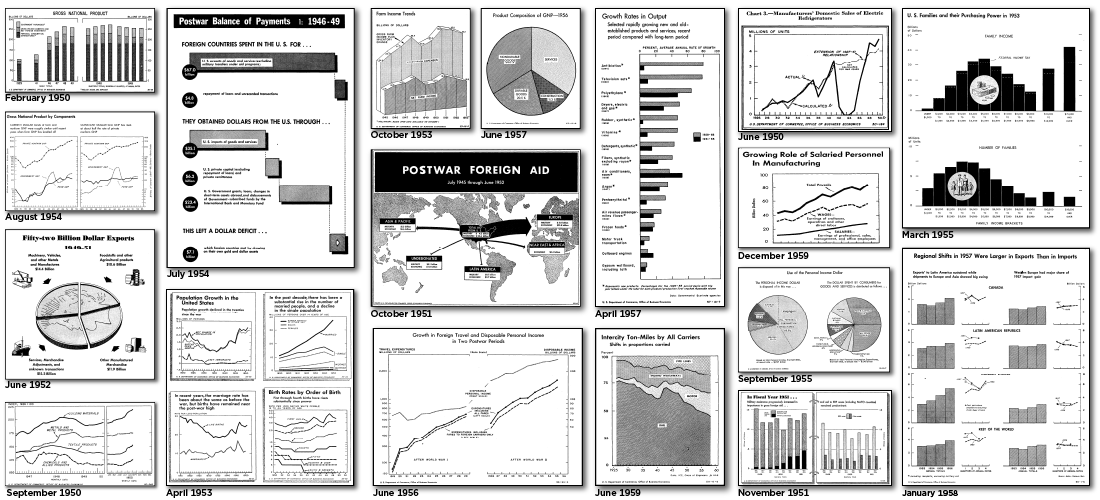
[Click to expand]
The Survey continued its tradition of creating informative, visually appealing charts and graphs in the 1950s, featuring data on GNP, imports and exports, population growth, postwar foreign aid, travel and transportation, the purchasing power of U.S. families, and countless other topics.

[Click to expand]
The Survey continued publishing an annual issue each February during the 1950s. In July 1950, the Survey published a national income issue, which soon became a second special issue, published each July from 1952 onward.
Annual issues during the 1950s
1950 • 1951 • 1952 • 1953 • 1954 • 1955 • 1956 • 1957 • 1958 • 1959
National income issues during the 1950s
1950 • 1952 • 1953 • 1954 • 1955 • 1956 • 1957 • 1958 • 1959

[Click to expand]
The Survey continued to publish the balance of international payments series of articles in the early 1950s, taking up the subject again with the “Developments in the U. S. Balance of International Payments” article in 1957. An example of a smaller series of articles is the two articles published on retail trade.
Balance of international payments articles
6/1950 • 9/1950 • 3/1951 • 6/1951 • 3/1952 • 3/1957
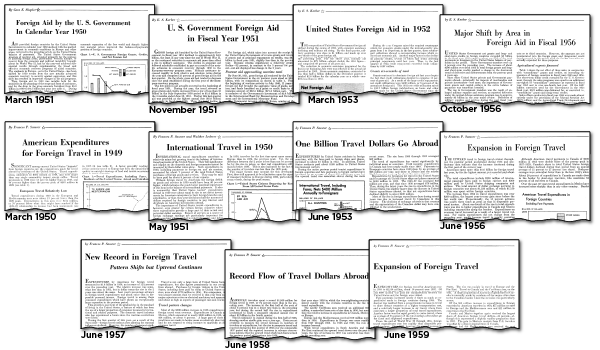
[Click to expand]
The Survey published a number of articles on recurring subjects throughout the 1950s. As the U.S. government, businesses, and citizens reconnected with Europe and Asia after World War II, many of these articles centered on foreign aid, foreign travel, and the flow of travel dollars.
Foreign aid articles
3/1951 • 11/1951 • 5/1952 • 10/1952 • 3/1953
10/1953 • 10/1956 • 4/1957 • 4/1958
Foreign travel and flow of travel dollars articles
3/1950 • 5/1951 • 6/1953 • 6/1956 • 6/1957 • 6/1958 • 6/1959
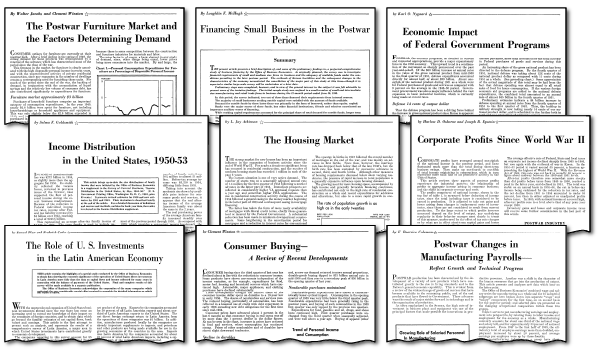
[Click to expand]
Interesting special articles that ran in the Survey in the 1950s included “The Demand for Furniture,” “Financing Small Business in the Postwar Period,” “Economic Impact of Federal Government Programs,” “Income Distribution in the United States, 1950–53,” “The Housing Market,” “Corporate Profits Since World War II,” “The Role of U. S. Investments in the Latin American Economy,” “Consumer Buying—A Review of Recent Developments,” and “Postwar Changes in Manufacturing Payrolls.”

[Click to expand]
A selection of advertisements featured in 1950s issues of the Survey included many for Department of Commerce publications, supplements to the Survey, and statistical references.
Stay tuned as we continue to highlight historical Survey content from the BEA archives.